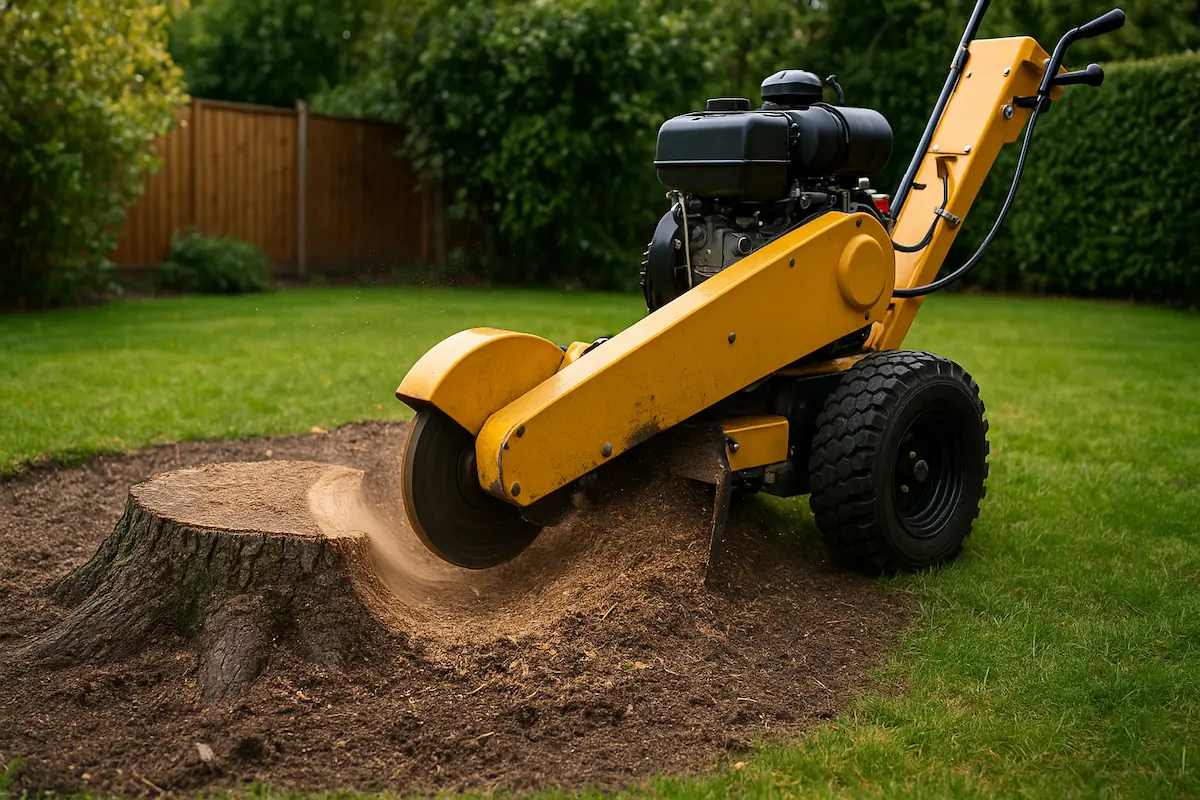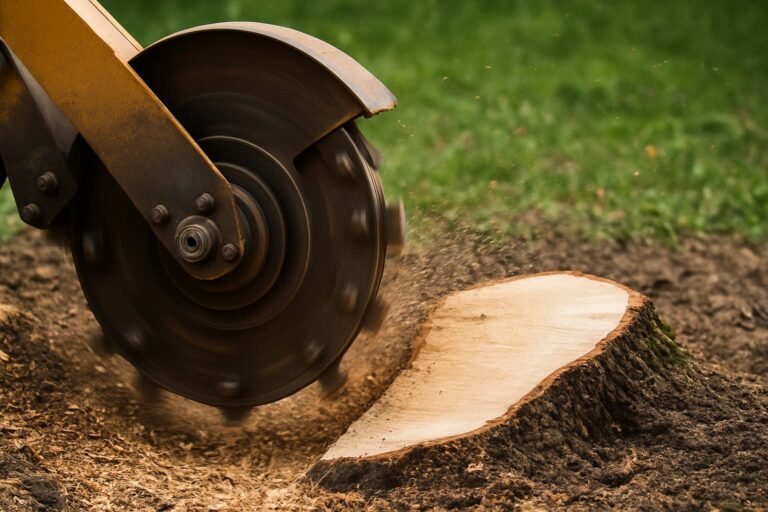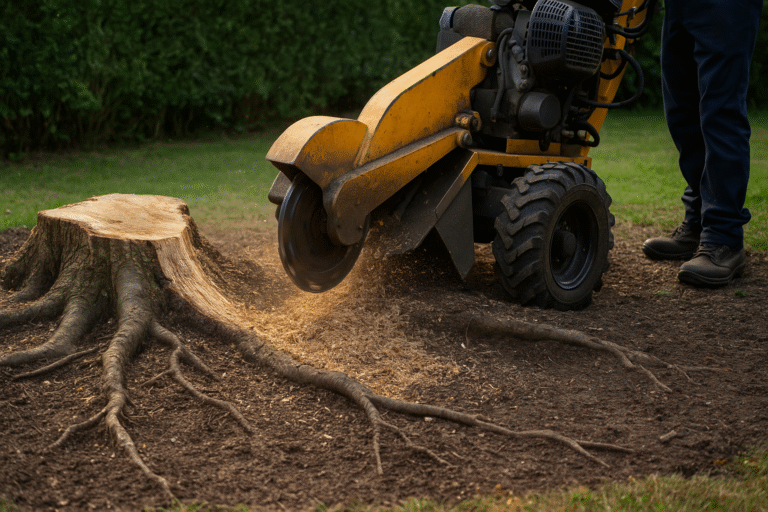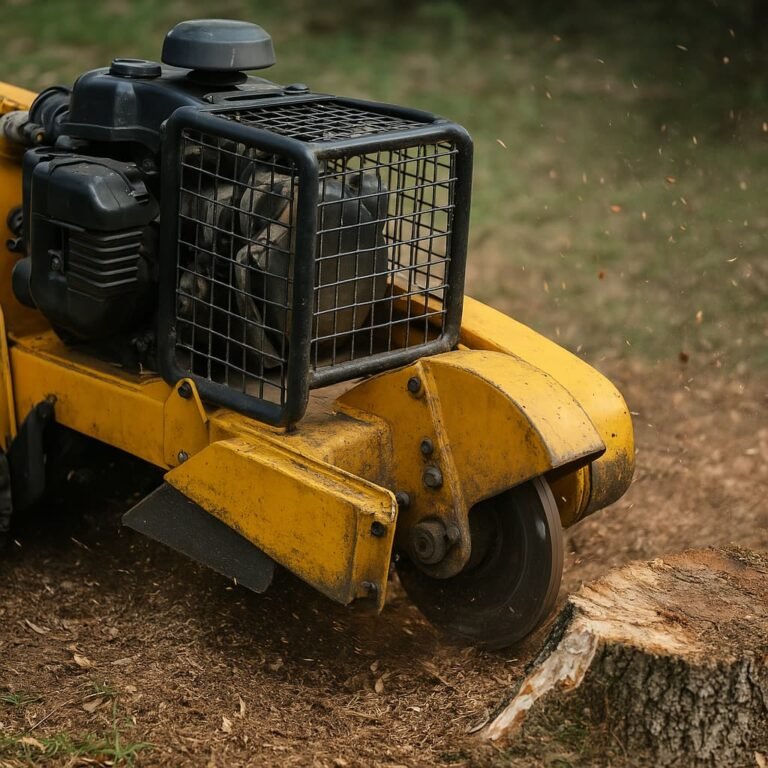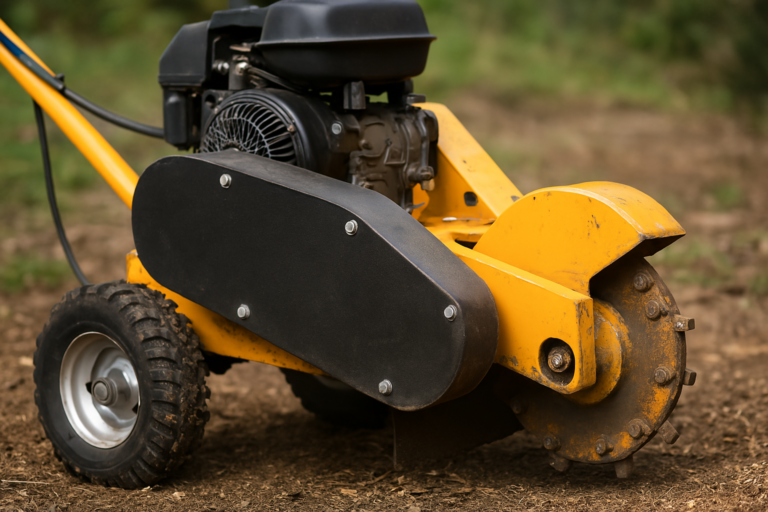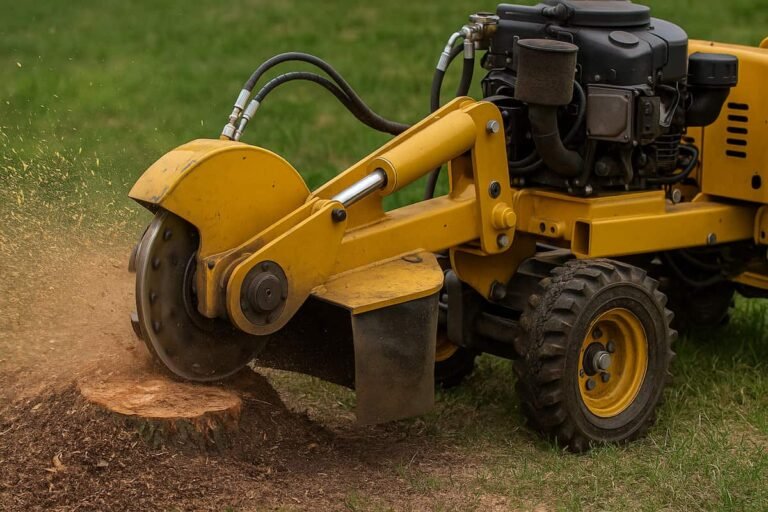Mastering Stump Grinder Working Width: Your UK Hire Guide for Efficiency
Picking the right stump grinder saves you time and money. Understanding working width is key.
It helps you choose the perfect machine from our UK hire fleet for your job.
Mastering Stump Grinder Working Width: Your UK Hire Guide for Efficiency
Key Takeaways: Optimal Stump Grinder Working Width
- Compact Grinders (20-35 inches): Ideal for small stumps (e.g., rose bushes) and jobs in tight garden spaces or through narrow gates, prioritizing maneuverability and precision.
- Mid-Range Grinders (35-50 inches): Offer a versatile balance for most common garden stumps (e.g., apple or birch trees, typically 2-4 feet wide), providing good efficiency without being overly bulky.
- Large/Commercial Grinders (50-80+ inches): Designed for maximum efficiency on very large stumps (e.g., oak or conifer trees, over 4 feet wide) and in open areas, significantly reducing job time and fuel consumption for professional results.
- Efficiency is Key: Choosing the right working width is crucial for saving time, fuel, and labour costs, ensuring a faster and more cost-effective stump removal project tailored to your specific needs.
What is the Stump Grinder’s Working Width? (And Why it Matters for Your Project)
Working width indicates the number of stumps a grinder can clear simultaneously. It is an essential feature of any stump grinding machine. Knowing this number helps you select the most suitable tool for your task.
Defining “Working Width”: Understanding the Stump Grinder’s Sweep Arc
The working width is the side-to-side movement of the grinder’s spinning wheel.
Think of it like a windscreen wiper on a car.
The wiper sweeps across a particular area.
A stump grinder’s cutting wheel does the same.
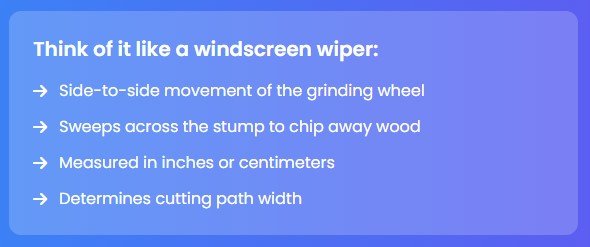
It sweeps across the stump to chip away wood.
This “sweep arc” is what we refer to as the working width.
It measures the width of a path that the cutting wheel can cover.
The measurement is usually in inches or centimetres.
Why Working Width is Critical for Efficient Stump Removal
A wider working width means fewer passes are required.
Imagine painting a large wall.
A wide roller finishes faster than a small brush.
Stump grinding works the same way.
A wider sweep arc means the grinder removes more stump with each pass.

This saves you lots of time.
It also means you use less fuel.
Fewer passes also mean less wear on the machine.
This makes your job quicker and cheaper overall.
For example, a professional arborist once told us:
“As a pro, I always go for the widest sweep I can get. Time is money, and a 70-inch working width lets me clear big stumps way faster than the smaller units.”
This demonstrates the high value that professionals place on this feature.
Working Width in Action: Visualising Your Grind for UK Conditions
Seeing how working width performs helps you understand its impact. It makes a big difference to your job. This applies whether you are a homeowner or a trade professional.
How a Wider Sweep Reduces Passes and Speeds Up Completion
A stump grinder moves its cutting wheel back and forth.
This motion chips away at the stump.
If the working width is small, you make many narrow cuts.
You must move the machine more often.
This takes more time and effort.
A wider working width makes wider cuts.
You cover more of the stump with each sweep.
This means you finish the job much faster.
It reduces the total number of passes required.
For a 3-foot wide oak stump, a machine with a 60-inch working width might clear it in just a few sweeps.
A machine with a 25-inch working width would need many more sweeps.
It would take much longer to grind the same stump.
See it to Believe it: The Visual Impact of Working Width on Stump Size.
Imagine a giant tree stump, say 5 feet across.
A small walk-behind grinder typically has a working width of 25 inches.
You would need to make many, many minor cuts.
The grinder would chip away at the stump little by little.
This process looks slow and repetitive.
Now, imagine a large self-propelled grinder.
It might have a 70-inch working width.
This machine can cover the entire 5-foot stump in one or two broad sweeps.
It looks much more powerful and quick.
The difference in speed is immediately apparent.
It demonstrates why selecting the correct working width is crucial for large stumps.
Choosing the Right Working Width for Your UK Stump Grinder Hire
The size of your stump and its location help you determine the best working width. We have machines for every kind of job. Think about your specific needs.
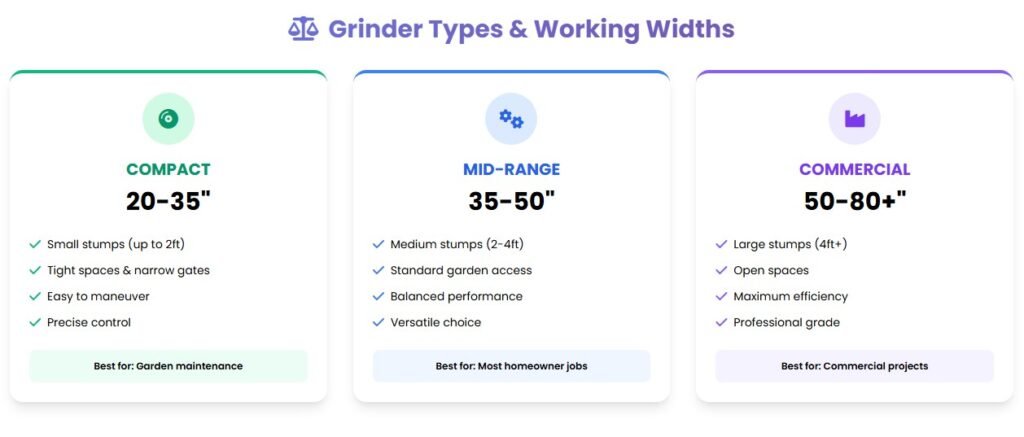
Small Stumps & Tight Spaces: When a Compact Working Width is Ideal
For small stumps, a compact grinder is often the best option.
These typically have a working width of 20 to 35 inches.
They are perfect for stumps from small shrubs or bushes.
They work well in gardens with narrow paths or gates.
A smaller machine makes it easier to move around flower beds.
It offers more control in tight spots, such as near fences or walls.
One customer noted:
“Hired a compact grinder for a backyard job with narrow gate access. Its small working width (about 20 inches) meant more passes, but it was the only thing that would fit. The trade-off was worth it for accessibility.”
This highlights the balance between width and access.
- Ideal for: Stumps up to 2 feet wide.
- Great for Narrow garden gates or tight spots.
- Pros: Easy to move, precise, suitable for small jobs.
- Cons: Slower for big stumps, needs more passes.
Medium Stumps & Standard Access: The Versatile Choice for Balanced Performance
For most common tree stumps, a mid-range working width works well.
These machines usually have a working width of 35 to 50 inches.
They are suitable for medium-sized trees, such as apple or birch.
They offer a good balance of speed and ease of use.
You can finish most stumps efficiently.
These grinders are still small enough to fit through many garden gates.
They are a very popular choice for many homeowners.
They give you good power without being too bulky.
- Ideal for: Stumps between 2 and 4 feet wide.
- Great for: Average garden sizes and standard access.
- Pros: Good speed, decent manoeuvrability, versatile.
- Cons: Not as fast as larger machines for huge stumps.
Large Stumps & Open Areas: Maximising Your Efficiency with the Widest Sweep
When you have a giant stump, go for a wide working width.
These powerful machines typically have a sweep of 50 inches or more.
Some can go up to 80 inches or even wider.
They are perfect for large oak, conifer, or commercial stumps.
You can use these in open fields or large garden spaces.
They make speedy work of huge stumps.
Professionals often opt for these for large projects.
They save immense amounts of time and effort.
A wide working width means fewer times you need to adjust the machine.
- Ideal for: Stumps over 4 feet wide.
- Great for Open spaces, professional jobs, and multiple stumps.
- Pros: Super fast, highly efficient, powerful.
- Cons: Larger size, might not fit through narrow gates.
Beyond the Numbers: Practical Considerations for Optimal Working Width
Numbers are a good start, but real-world conditions are also necessary. Consider how the machine will fit and be moved on your property. This helps you make the right hire choice.
Working Width vs. Machine Width: Avoiding This Common Confusion
People often confuse working width with machine width.
Machine width is how wide the whole grinder is.
This is important for getting it through gates or tight spots.
Working width is how wide the cutting wheel can move.
It can often be wider than the machine itself.
Some grinders have cutter heads that swing out past their wheels.
Always check both numbers.
The machine width indicates whether it will fit.
The working width indicates how quickly it will grind.
Callout: Always check both “Machine Width” for access and “Working Width” for grinding speed.
Navigating Tight Access: The Trade-off Between Speed and Maneuverability
Sometimes, the fastest grinder is not the best.
If your garden gate is only 28 inches wide, you need a narrow machine.
Even if it has a small working width, it’s the only one that fits the bill.
You might take longer to grind the stump.
But at least you can get the job done.
This is a standard choice homeowners face.
A slightly slower grind is better than no grind at all.
Consider your access points before selecting your grinder.
Ground Conditions and Terrain: Impacting Your Grinder’s Performance
The type of ground can affect how your grinder works.
Uneven ground can make it harder to get a full sweep.
Slopes can make the machine less stable.
This might mean you cannot use the full working width safely.
Always ensure the ground is as level as possible.
Clear away any debris or obstacles.
This helps the grinder work at its best.
It allows you to utilise the full working width effectively.
Operator Skill Level: Making the Most of Your Grinder’s Width
A skilled operator can make any grinder more efficient.
They know how to make smooth, consistent passes.
They get the most out of the machine’s working width.
If you are new to grinding, take your time.
Read the instructions carefully.
Practice safe operation.
Even with a smaller working width, good technique is still beneficial.
It makes sure you remove the stump safely and completely.
Quantifying Efficiency: How Working Width Impacts Your Job Time & Cost
Choosing the correct working width directly impacts your wallet. It can save you hours of work. This means less money spent on hire fees and fuel.
Real-World Scenarios: Estimating Time Savings by Stump Size
Let’s look at some examples.
Scenario 1: Small Stump in a UK Garden
- Stump: 1.5 feet (45 cm) diameter, old rose bush.
- Machine 1: Compact walk-behind grinder, 25-inch working width.
- Time estimate: Approximately 10-15 minutes (plus setup time). It covers the stump quickly.
- Machine 2: Large commercial grinder, 60-inch working width.
- Time estimate: Approximately 5-10 minutes (plus setup time). Overkill, but very fast.
- Conclusion: For small stumps, the efficiency gain from a large machine is less dramatic. Both are quick enough.
Scenario 2: Medium Stump in a UK Back Garden
- Stump: 3 feet (90 cm) diameter, old cherry tree.
- Machine 1: Mid-range grinder, 40-inch working width.
- Time estimate: Approximately 20-30 minutes (plus setup time). This is a good match.
- Machine 2: Compact walk-behind grinder, 25-inch working width.
- Time estimate: Approximately 40-60 minutes (plus setup time). You will make many passes, tiring work.
- Conclusion: The mid-range grinder saves you a reasonable amount of time and effort here.
Scenario 3: Large Stump in an Open Field (Commercial Job)
- Stump: 5 feet (150 cm) diameter, giant oak tree.
- Machine 1: Large self-propelled grinder, 70-inch working width.
- Time estimate: Approximately 45-60 minutes (plus setup time). This machine tackles it easily.
- Machine 2: Mid-range grinder, 40-inch working width.
- Time estimate: Around 2-3 hours (plus setup). This would be a very long and tiring job.
- Conclusion: For large stumps, a wider working width is essential. It saves hours of work.
One satisfied customer said: “My old machine had a tiny sweep, and it felt like I was there all day for a medium stump. The rental unit with the wider cutting arc was a game-changer, finished in half the time.” This directly shows the time-saving.
Hire Cost vs. Efficiency: Making a Smart Investment in Your Project
Hiring a machine with a wider working width might cost slightly more per day.
But consider the time it saves.
If a wider machine finishes the job in 2 hours instead of 4 hours, you save money.
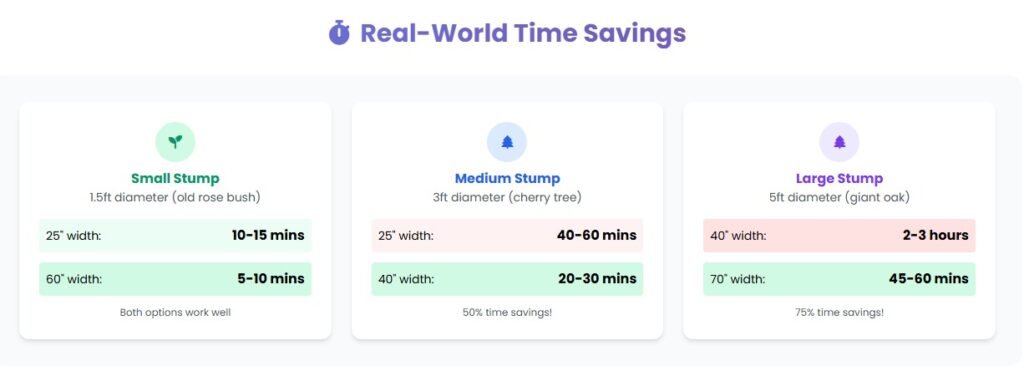
You pay for fewer hours or fewer days of hire.
You also save on your own labour time.
For a homeowner, this means more free time.
For a professional, it means they can do more jobs.
A good working width is an investment in your time and efficiency.
Reducing Labour and Fuel Costs with an Optimised Working Width
Every minute a grinder runs, it uses fuel.
Every minute you operate it that is your labour time.
A wider working width means fewer passes overall.
This means the machine runs for less time.
You use less fuel, saving money.
You also spend less time working.
This reduces your labour costs, whether it’s your own time or that of paid workers.
Think about a 4-foot stump.
A 60-inch working-width machine might use 5 litres of fuel.
A 30-inch working-width machine might use 10 litres of fuel to do the same job.
This is a real saving over time.
Common Problems Summary: Don’t Get Caught Out!
- Choosing too small a working width for a significant stump Leads to many passes, long job time, more fuel used, and operator fatigue.
- Confusing machine width with working width: You might hire a machine that doesn’t fit through your gate, even if its cutting width is good.
- Ignoring ground conditions: Uneven ground can stop you from using the full working width safely or efficiently.
- Underestimating job time: Picking the wrong working width can double or triple the time needed for a big stump.
Your UK Stump Grinder Hire Options: Machines by Working Width
We have a range of stump grinders ready for hire. We make it easy to find the right one for your job. Our team is here to help you make a choice.
Table: Typical Stump Grinder Working Widths & Best Use
| Grinder Type | Working Width (Approx.) | Best For | Key Benefit |
|---|---|---|---|
| Compact | 20-35 inches | Small stumps, tight gardens, narrow gates | Excellent manoeuvrability, precise for small jobs |
| Mid-Range | 35-50 inches | Medium stumps, general garden use | Good balance of speed and agility, versatile |
| Large/Commercial | 50-80+ inches | Large stumps, open spaces, professional jobs | Maximum speed and efficiency for big projects |
Frequently Asked Questions About Stump Grinder Working Width
Here are answers to common questions about working width. These help you make the best choice for your hire. We aim to make everything clear for you.
Do I Always Need the Widest Working Width Available for My Stump?
No, not always.
The widest working width is best for huge stumps.
It is also great for stumps in open areas.
But if you have a small stump, a smaller working width is fine.
It is often easier to handle.
If you have narrow gates, a smaller machine is a must.
Sometimes, a slightly slower grind is worth it for access.
The best working width matches your specific job.
What if My Stump is Wider Than the Grinder’s Stated Working Width?
This is very common.
Most stumps are wider than a single sweep.
You make several passes.
Start on one side of the stump.
Grind a section.
Then, move the machine slightly.
Grind the next section.
You repeat this process until the entire stump is gone.
Even a 25-inch working width can remove a 5-foot stump.
It just takes more time and more passes.
Can I Adjust a Grinder’s Working Width During Operation?
No, you cannot change the working width.
The working width is a fixed feature of the machine.
It depends on how the cutting head is designed.
It is part of the grinder’s engineering.
You choose a grinder based on its set working width.
You then operate it within that fixed sweep arc.
There are no knobs or levers to adjust the sweep, making it impossible to widen or narrow it.
Ready to Hire? Contact Us Today for Leading UK Stump Grinder Solutions
Understanding working width helps you pick the right tool. This saves you time, effort, and money. We have the perfect stump grinder for your project.

